Get work done right, and right-on-time with our industry leading BPM platform.
The Best Process Automation Tools for Small Businesses: A Comparison
Process automation tools are capable of automating most of your company’s operations.
They also centralize information, making it easy for everyone to access it quickly.
Automations can even remove bottlenecks and reduce errors.
This page will guide you through the best process automation tools available and help you choose the best one for you.
What are process automation tools?
Process automation tools encompass a range of software solutions designed to streamline and automate repetitive tasks, workflows, and business processes.
These tools typically leverage technologies such as robotic process automation (RPA), artificial intelligence (AI), and machine learning (ML) to automate manual activities and optimize operational efficiency.
The tools often provide features for process modeling, task scheduling, exception handling, and integration with other systems to enable end-to-end automation of business processes.
Best process automation tools

Process Street
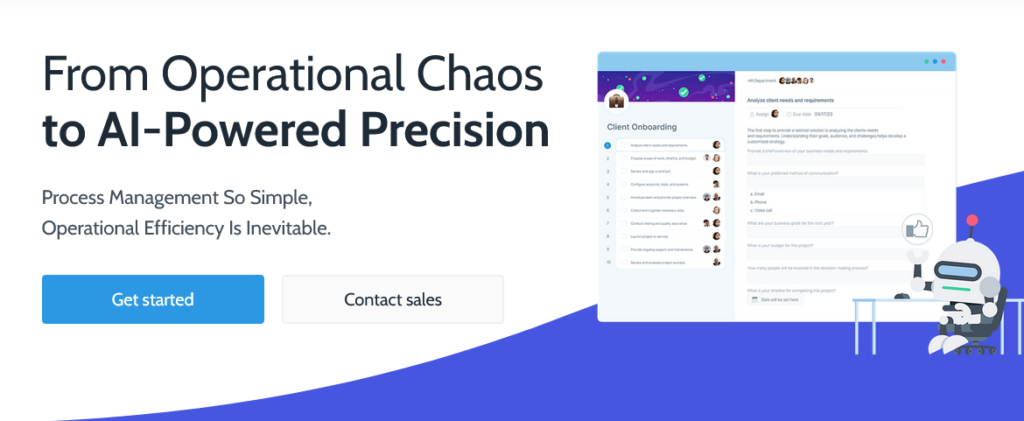
Interface: Process Street offers a user-friendly interface suitable for both beginners and advanced users.
Process complexity handling: It can handle all processes, regardless of complexity.
Support: Comprehensive support is available, including a Help Center, FAQs, email, and chat support.
Integrations: Process Street provides integration with thousands of other tools.
Personalization: Users can personalize their processes within the platform.
Features: Process Street is known for being one of the best process automation tools for small businesses. It offers tailored solutions for HR departments and scalable options for growing businesses. Additionally, it integrates seamlessly with CRM systems.
Pros: Process Street is a cloud-based solution, offers a no-code approach, and ensures data security.
UiPath

Interface: UiPath offers a user-friendly interface, particularly suitable for beginners.
Process complexity handling: It can handle all processes efficiently.
Support: Users can access video tutorials, community forums, and over-the-phone support.
Integrations: UiPath supports various integrations.
Personalization: While somewhat personalizable, UiPath’s customization options may be limited.
Features: UiPath provides affordable process automation tools for startups, strong customer support, and easy-to-use solutions for non-technical teams.
Pros: It offers low-code options, is free for individuals for testing, and features drag-and-drop functionality.
Cons: Customization options may be limited.
Blue Prism
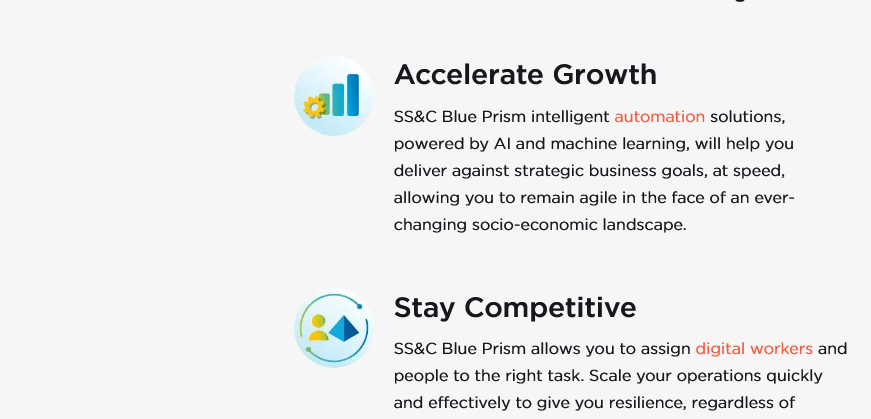
Interface: Blue Prism offers a user-friendly interface, particularly aimed at developers.
Process complexity handling: It can handle most processes effectively.
Support: Users can access video tutorials, guides, and email support.
Integrations: Blue Prism supports various integrations.
Personalization: Blue Prism offers personalization options.
Features: Blue Prism is known for its advanced analytics capabilities and suitability for project management.
Pros: It’s very reliable, features security for network credentials, and can be used across different platforms.
Cons: It requires programming skills and can be expensive at $15,000 per annum.
Automation Anywhere

Interface: Automation Anywhere provides a user-friendly interface suitable for all users.
Process complexity handling: It can handle many processes effectively.
Support: Users can access video tutorials for support.
Integrations: Automation Anywhere supports various integrations.
Personalization: Automation Anywhere does not offer personalization.
Features: It’s considered one of the top process automation tools for workflow management and offers advanced analytics capabilities.
Pros: It provides real-time analytics, powerful security through encryption and authentication options, and is applicable to multiple industries, especially those relying on security.
Cons: The interface could be improved
Pega
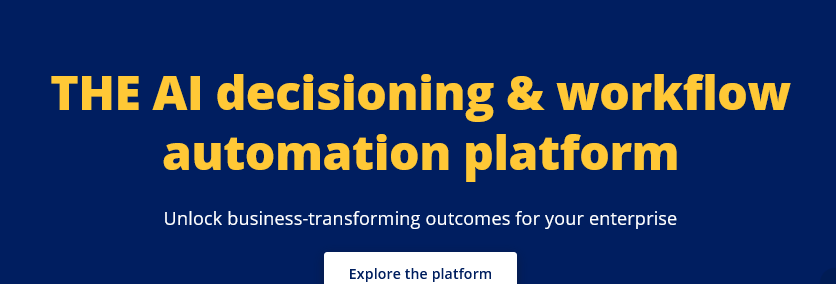
Process complexity handling: Pega is capable of handling complex processes.
Support: Pega provides comprehensive support.
Integrations: It supports various integrations.
Personalization: Pega is highly customizable.
Features: Pega offers BPM, RPA, AI, and case management functionalities.
Pros: It provides end-to-end automation capabilities and low-code options.
Cons: Pega can be costly and requires expertise in Pega.
Nintex

Process complexity handling: Nintex can handle various processes.
Support: Nintex offers support.
Integrations: It supports integrations.
Personalization: Nintex provides customizable workflows.
Features: Nintex specializes in workflow automation and document generation.
Pros: It is user-friendly and integrates well with SharePoint.
Cons: Nintex may have limited advanced AI capabilities.
Appian
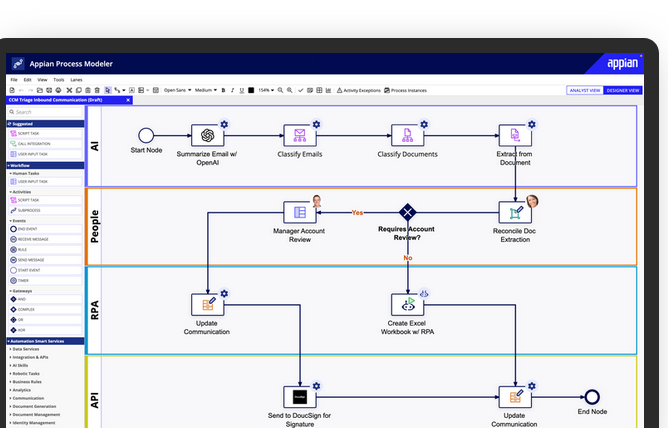
Process complexity handling: Appian handles complex processes.
Support: Appian provides support.
Integrations: It supports integrations.
Personalization: Appian offers a customizable low-code platform.
Features: Appian offers BPM, case management, and low-code development features.
Pros: It is low-code and easy to use.
Cons: Appian may have limited advanced AI capabilities, and pricing can be high.
Microsoft Power Automate
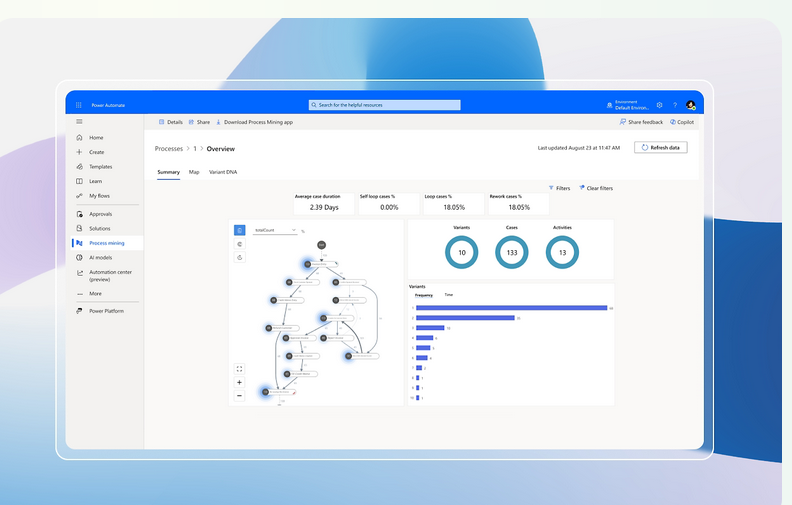
Process complexity handling: Microsoft Power Automate handles a wide range of processes.
Support: Microsoft offers support.
Integrations: It supports extensive integrations.
Personalization: Microsoft Power Automate provides customizable workflows.
Features: Microsoft Power Automate offers workflow automation and connectors to Microsoft products.
Pros: It integrates well with the Microsoft ecosystem and is user-friendly.
Cons: It may lack advanced AI capabilities.
Zapier
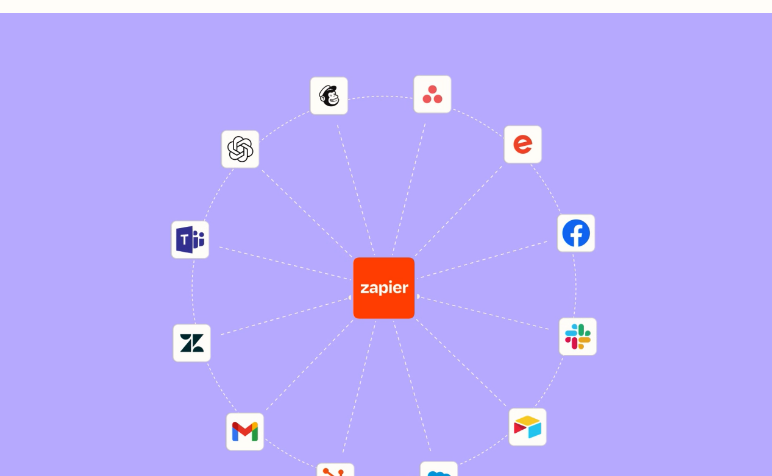
Process complexity handling: Zapier handles simpler automation tasks.
Support: Zapier offers support with paid plans.
Integrations: It supports extensive integrations.
Personalization: Zapier provides customizable workflows.
Features: Zapier connects web apps and automates tasks.
Pros: It is user-friendly and supports a broad range of apps.
Cons: Zapier may have limited capabilities for complex automation tasks.
Kissflow

Process complexity handling: Kissflow can handle various processes.
Support: Kissflow offers support.
Integrations: Integrations are available.
Personalization: Kissflow allows customizable workflows.
Features: It specializes in BPM, workflow automation, and forms.
Pros: Kissflow is user-friendly and affordable.
Cons: It may have limited AI capabilities.
WorkFusion
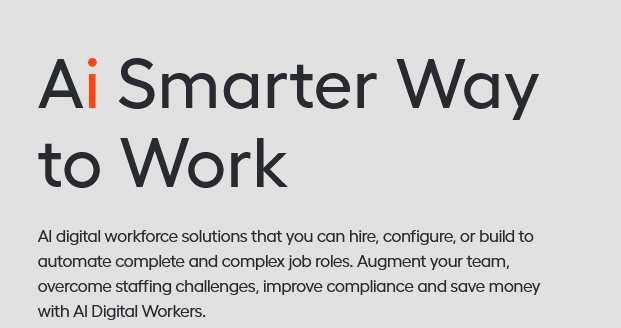
Process complexity handling: WorkFusion is especially suitable for data-centric processes.
Support: WorkFusion provides support.
Integrations: It supports integrations.
Personalization: WorkFusion offers customizable RPA solutions.
Features: WorkFusion specializes in RPA, AI, and data extraction.
Pros: It has strong data automation capabilities and supports machine learning.
Cons: WorkFusion may require technical expertise
What is a process automation tool?
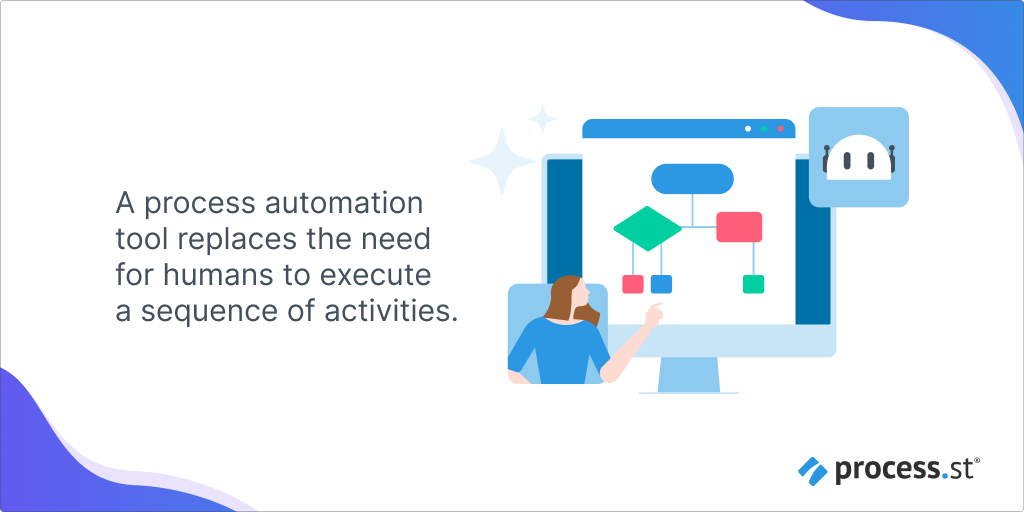
You can use a process automation tool to automate nearly all aspects of your business and in all departments.
These tools can handle complex processes critical for your company to grow.
Types of process automation tools
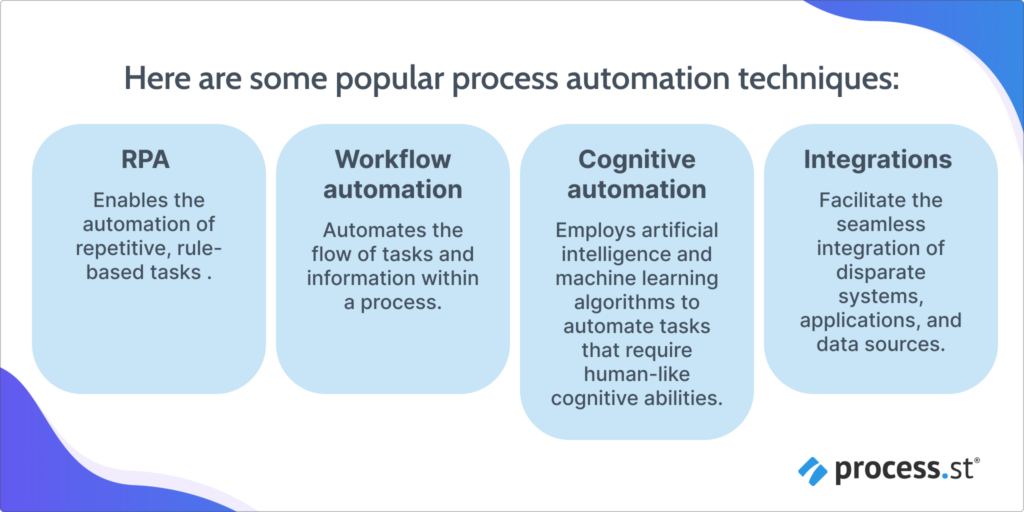
Essentially, there are three types of automation tools you should be aware of:
- Macros
- Robotic Process Automation (RPA)
- IT Process Automation (ITPA)
The process management software you end up choosing depends on your company’s needs and size, but here’s how they differ.
Macros
Macros date back to when Excel was born.
These very basic tools don’t do well with large sets of data. Instead, they can create spreadsheets, shortcuts, and remove duplicates.
This makes them not only the easiest of the three but also the less capable.
RPA
These process automation tools are quite easy to use and perfect for beginners.
They are no-code and rely on their drag-and-drop functionality. This means that everyone in your company can benefit from using them.
RPAs are especially useful in running all day-to-day company processes. From opening emails, building a workflow, and monitoring security systems, RPAs are a great all-rounder.
ITPA
ITPAs are particularly popular in the IT sector.
They differ from RPAs because RPAs can automate a large variety of daily processes without using advanced techniques.
ITPAs are capable of automating all processes, including very complex ones. For example, ITPAs can handle, monitor, and configure virtual servers.
Key process automation tool features
We’ve created a list of the 5 process automation features all tools should have:
High usability
Your tool of choice adds value immediately. It should also be able to handle multiple processes with ease. Ensure that you can utilize the tool throughout your organization and on a day-to-day basis.
Integration with third-party apps
Look for tools that offer as many integrations as possible. This will make your life much easier because it will eliminate having to jump from one app to the next.
User-friendliness
It should go without saying, but a good automation tool should have a clear and user-friendly interface.
Support
Any tool you ever buy should come with added support. Whether it’s phone or email-based, adequate support should always be available.
Dynamic and personalizable
You’ll want a process automation tool that you can personalize to meet your needs. Find one that is as visually appealing as it is customizable.
How to use process automation tools
Here are our top tips for implementing and using process automation tools effectively:
Make a list of all processes that need re-designing
This will allow you to analyze your business requirements and clarify what needs to be automated first.
Assess all the available tools
Make sure to read as much about their features as possible. Verify which tools fit your business objectives.
Choose the right tool
Only choose the tool that offers adequate support and a knowledge base. You don’t want to buy software that delivers no training on how to use it.
Test, test, test
Before implementing any changes, ensure you test them first. And keep in mind that it may take some time for the results to show. Sometimes you’ll have to keep tweaking things until they start working as expected.
Process automation tools testimonials
Below you’ll find testimonials from some of our clients that have successfully used Process Street to automate their work:
“Very user-friendly. Workflow automatization is a great tool. I love how you can schedule the workflow runs and it reminds you when it needs to be run. We use checklists daily to ensure we comply with our business needs.”
Ebano C., Senior IT Support (medium business)
“Straightforward interface and a great set of tools to help map processes. I like the conditional logic feature, which allows you to hide or show elements of the process based on the options/outcomes you choose.”
Matthew P., Strategic Account Manager (small business)
“I love how Process Street makes it so straightforward, especially when it comes to highly detailed work like onboarding new staff and other similar processes. You can modify their pre-made templates to suit your needs or build your own from scratch.”
Sam O., Regional Property Management Director (small business)
Benefits of process automation tools
Deciding on an automation tool can be tricky, as there are many currently on offer.
So before you take your pick, ensure that it fits with your business objectives. And you can also take advantage of our must-have features list to help you select the best tool.
But what are the benefits of using process automation tools?
Here are just a few:
- They boost productivity by passing on tasks to robots
- They save costs by eliminating the time spent on repetitive tasks
- They reduce errors by avoiding manual data entry
- They increase productivity by letting employees focus on important issues
Are there any disadvantages of business process automation tools?
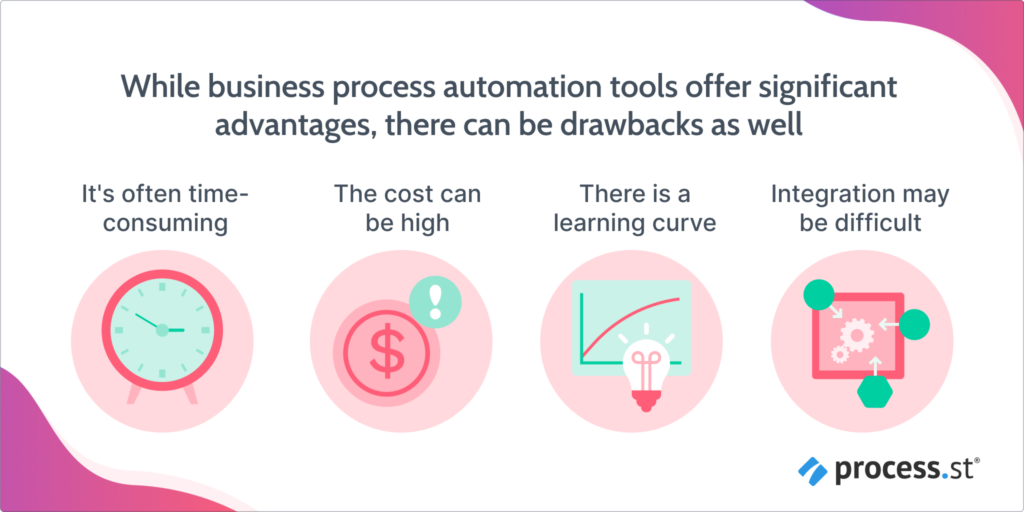
While business process automation tools offer significant advantages, there can be drawbacks as well.
Some complex business processes may be difficult to automate completely, requiring human intervention in certain cases.
It’s often time-consuming
The initial setup and implementation of these tools can be time-consuming and resource-intensive.
The cost can be high
Additionally, the cost of acquiring and maintaining business process automation software may be a consideration for some organizations.
There is a learning curve
Users may also face a learning curve when familiarizing themselves with these tools, and ongoing training and support may be needed.
Integration may be difficult
Finally, integrating automation tools with legacy systems can present challenges, requiring additional customization and development efforts.
Despite these potential disadvantages, the benefits of business process automation tools, such as improved operational efficiency and greater return on investment, often outweigh the drawbacks for organizations looking to optimize their processes and enhance their overall performance.
Considerations for implementing a business process automation tool
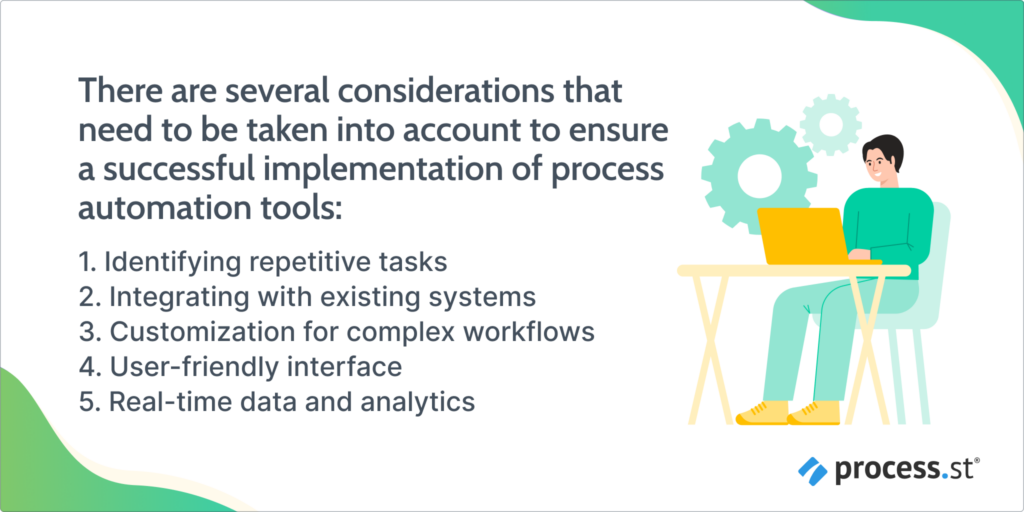
Implementing a business process automation tool is a strategic decision that can greatly benefit organizations by streamlining operations and improving efficiency.
However, there are several considerations that need to be taken into account to ensure a successful implementation.
1. Identifying repetitive tasks
Before implementing a business process automation tool, it is crucial to identify the repetitive tasks within an organization.
By automating these tasks, businesses can free up valuable time and resources, allowing employees to focus on more strategic initiatives.
2. Integrating with existing systems
Another important consideration is the ability of the automation tool to seamlessly integrate with existing systems.
This ensures that data can be easily shared across platforms, eliminating the need for manual data entry and reducing errors.
3. Customization for complex workflows
Automation tools should have the capability to handle complex workflows and accommodate the unique processes of different business units.
Customization options, such as drag-and-drop interfaces and rule-based logic, allow businesses to tailor the tool to their specific requirements.
4. User-friendly interface
A user-friendly interface is essential for the successful adoption of a business process automation tool.
Non-technical users should be able to easily understand and navigate the tool without the need for extensive training.
5. Real-time data and analytics
A robust automation tool should provide real-time data and analytics to enable organizations to monitor and optimize their processes.
This data-driven approach allows for greater visibility into operations, enabling businesses to make informed decisions and continuously improve their workflows.
What are some process automation techniques?
RPA
Robotic process automation (RPA) involves deploying software robots to mimic human interactions with digital systems.
This enables the automation of repetitive, rule-based tasks across various applications and systems without the need for extensive integration.
Workflow automation
Workflow automation automates the flow of tasks and information within a process, ensuring seamless handoffs between different stages and stakeholders.
Workflow automation tools often feature visual designers for creating and managing workflows, along with integration capabilities to connect disparate systems.
Cognitive automation
Cognitive automation employs artificial intelligence (AI) and machine learning (ML) algorithms to automate tasks that require human-like cognitive abilities, such as natural language processing, pattern recognition, and decision-making.
This enables automation of complex and unstructured processes that traditional rule-based automation may struggle with.
Integrations
Integration platforms facilitate the seamless integration of disparate systems, applications, and data sources, enabling automated data exchange and process orchestration across the organization.
These platforms often include connectors, APIs, and middleware for integrating various technologies and systems into unified workflows and processes.
Identifying the right platform for your organization’s needs
When identifying the right platform for your organization’s needs, several factors must be considered.
These factors will help ensure that the chosen platform aligns with your specific requirements and objectives.
Consider the nature of business processes
Firstly, consider the nature of your business processes.
Some organizations may have simple and repetitive tasks that need automation, while others may have complex workflows requiring advanced capabilities.
Assessing the complexity and variety of your business processes will help you determine the level of automation and the features you need from a platform.
Technical expertise of your team
Secondly, consider the technical expertise of your team.
Some platforms require coding or automation expertise, while others offer a user-friendly interface with drag-and-drop functionalities.
Assessing the level of technical expertise within your organization will help you select a platform that matches the skills of your team members.
What features do you need?
Next, consider the desired features and capabilities.
Each platform may offer a wide range of features, such as real-time data, task assignments, third-party integrations, and customer experience management. Evaluating your organization’s specific requirements will help you choose a platform that meets your desired feature set.
Ultimately, identifying the right platform for your organization’s needs requires carefully evaluating factors such as business processes, technical expertise, and desired features.
By considering these factors and exploring the capabilities of different automation tools, you can make an informed decision that aligns with your organization’s goals and ensures a successful digital transformation.







 Workflows
Workflows Projects
Projects Data Sets
Data Sets Forms
Forms Pages
Pages Automations
Automations Analytics
Analytics Apps
Apps Integrations
Integrations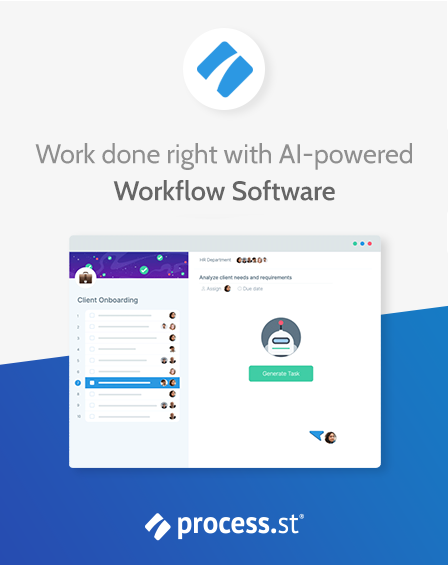
 Property management
Property management
 Human resources
Human resources
 Customer management
Customer management
 Information technology
Information technology


